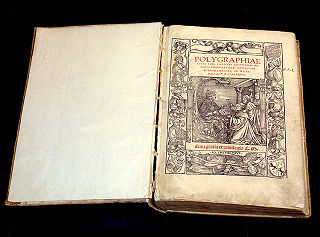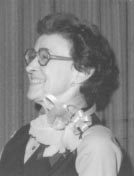
A crossword is a word puzzle that usually takes the form of a square or a rectangular grid of white- and black-shaded squares. The goal is to fill the white squares with letters, forming words or phrases, by solving clues which lead to the answers. In languages that are written left-to-right, the answer words and phrases are placed in the grid from left to right ("across") and from top to bottom ("down"). The shaded squares are used to separate the words or phrases.

Arlington Hall is a historic building in Arlington, Virginia, originally a girls' school and later the headquarters of the United States Army's Signal Intelligence Service (SIS) cryptography effort during World War II. The site presently houses the George P. Shultz National Foreign Affairs Training Center, and the Army National Guard's Herbert R. Temple, Jr. Readiness Center. It is located on Arlington Boulevard between S. Glebe Road and S. George Mason Drive.

Books on cryptography have been published sporadically and with highly variable quality for a long time. This is despite the tempting, though superficial, paradox that secrecy is of the essence in sending confidential messages — see Kerckhoffs' principle.

Herbert Osborn Yardley was an American cryptologist. He founded and led the cryptographic organization the Black Chamber. Under Yardley, the cryptanalysts of The American Black Chamber broke Japanese diplomatic codes and were able to furnish American negotiators with significant information during the Washington Naval Conference of 1921–1922. Recipient of the Distinguished Service Medal. He wrote The American Black Chamber (1931) about his experiences there. He later helped the Nationalists in China (1938–1940) to break Japanese codes. Following his work in China, Yardley worked briefly for the Canadian government, helping it set up a cryptological section of the National Research Council of Canada from June to December 1941. Yardley was reportedly let go due to pressure either from the Secretary of War Henry L. Stimson or from the British.

Louis William Tordella was the longest serving deputy director of the National Security Agency.

Joseph John Rochefort was an American naval officer and cryptanalyst. He was a major figure in the United States Navy's cryptographic and intelligence operations from 1925 to 1946, particularly in the Battle of Midway. His contributions and those of his team were pivotal to victory in the Pacific War.
The National Puzzlers' League (NPL) is a nonprofit organization focused on puzzling, primarily in the realm of word play and word games. Founded in 1883, it is the oldest puzzlers' organization in the world. It originally hosted semiannual conventions in February and September of each year, but conventions are now held annually, in July.

David Kahn is an American historian, journalist, and writer. He has written extensively on the history of cryptography and military intelligence.

William F. Shortz is an American puzzle creator and editor who is the crossword puzzle editor for The New York Times. He graduated from Indiana University with a degree in the invented field of "enigmatology". After starting his career at Penny Press and Games magazine, he was hired by The New York Times in 1993. Shortz's American Crossword Puzzle Tournament is the country's oldest and largest crossword tournament.

Bobby Ray Inman is a retired United States Navy admiral who held several influential positions in the United States Intelligence Community.
The Signal Intelligence Service (SIS) was the United States Army codebreaking division through World War II. It was founded in 1930 to compile codes for the Army. It was renamed the Signal Security Agency in 1943, and in September 1945, became the Army Security Agency. For most of the war it was headquartered at Arlington Hall, on Arlington Boulevard in Arlington, Virginia, across the Potomac River from Washington (D.C.). During World War II, it became known as the Army Security Agency, and its resources were reassigned to the newly established National Security Agency (NSA).

Henry Hook was an American creator of crossword puzzles, widely credited with popularizing the cryptic crossword in North America. With Henry Rathvon and Emily Cox, he wrote the crossword for the Boston Globe.
Norman "Trip" Payne is an American professional puzzle maker. He is known by many as a three-time champion of the American Crossword Puzzle Tournament (ACPT). With his first victory in 1993, at the age of 24, Payne became the youngest champion ever in the tournament's history, a record he held until 2005.
The United States' National Security Agency (NSA), an intelligence agency of the federal government, publishes many documents on the history and technology of cryptology, cryptography, and cryptanalysis through various publications.
Frank Waring Lewis was an American cryptographer and cryptic crossword compiler. His puzzles were printed in The Nation for over 60 years, for a total of 2,962 puzzles. Leonard Bernstein, Kurt Vonnegut, and Katha Pollitt were listed among the fans of his puzzles.

Elonka Dunin is an American video game developer and cryptologist. Dunin worked at Simutronics Corp. in St. Louis, Missouri from 1990–2014, and in 2015 was Senior Producer at Black Gate Games in Nashville, Tennessee. She is Chairperson Emerita and one of the founders of the International Game Developers Association's Online Games group, has contributed or been editor in chief on multiple IGDA State of the Industry white papers, and was one of the Directors of the Global Game Jam from 2011–2014. As of 2020 she works as a management consultant at Accenture.

Cicada 3301 is a nickname given to three sets of puzzles posted under the name "3301" online between 2012 and 2014. The first puzzle started on January 4, 2012, on 4chan and ran for nearly a month. A second round began one year later on January 4, 2013, and then a third round following the confirmation of a fresh clue posted on Twitter on January 4, 2014. The third puzzle has yet to be solved. The stated intent was to recruit "intelligent individuals" by presenting a series of puzzles to be solved; no new puzzles were published on January 4, 2015. A new clue was posted on Twitter on January 5, 2016. Cicada 3301 posted their last verified OpenPGP-signed message in April 2017, denying the validity of any unsigned puzzle.

Gene Grabeel was an American mathematician and cryptanalyst who founded the Venona project.

People Puzzler is an American television game show hosted by Leah Remini and broadcast by Game Show Network. It premiered on January 18, 2021.














